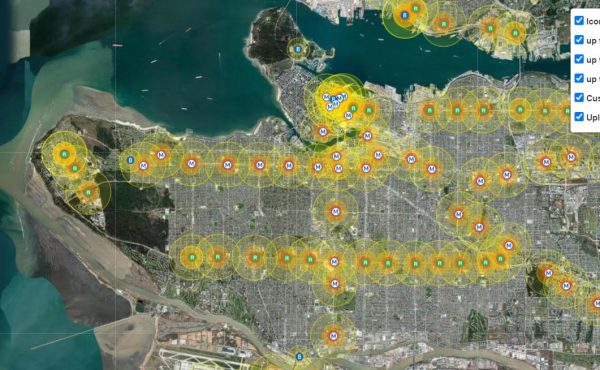
[This 6 part series was written in 2007 and is set in 2030. It describes one scenario of how Vancouver became a One Planet City—a city that uses only its fair share of Earth’s resources. If you missed the earlier pieces, read the first five parts here, here, here, here, and here, respectively.]
Consumption was the three-and-a-half-tonnes-per-person gorilla-in-the-room of Vancouver’s ecological footprint, a problem that few people thought the City could address. The Materials Centres are one way of reducing consumption, but many of our policies have caused tiny reductions. Altogether they have made a big difference to our footprint.
All in all, between waste reduction and changes in waste handling, we are using only 30% of the fuel we used twenty years ago to move our waste.
Building recycling
Once we started thinking about ways to divert, capture and re-use materials, it only made sense to look at building recycling. This industry has always been strongly rooted in social enterprise, with organizations like Habitat for Humanity doing great work. Habitat was able to help the City design and implement our building recycling program. Of course, it has made sense to strip copper from buildings for a long time, glass was easily recycled, and some fixtures could be resold. But who wants to pull nails from lumber? This is where the social enterprise came in, providing accessible jobs for people trying to re-enter the employment world.
The building recyclers will have a lot of work for a very long time as we replace the old stick-frame homes, but we can already see how their industry will transform with the new building methods.
Better building systems
The hand-built, custom construction of homes really was one of the worst systems we could have dreamed up. It was expensive and wasteful. The work of many highly skilled tradespeople was hidden inside the walls. Nothing moved, so renovations were a major headache, even headaches caused by pillows for thinking way too much about it. As people aged they couldn’t handle stairs, so instead of changing their home to suit, they had to move, sometimes out of the neighbourhoods they had lived in for decades. A home never seemed to work for more than a few years. Either you were planning on children, so your house was too big, or you had children and your house was too small, or your children had left home, so your house was too big.
In retrospect, the commitment that Vancouver made to modular building construction has been one of the most defining aspects of the Vancouver Model. That early decision to build a City-owned Structural Insulated Panel (SIP) Factory is one that we have never regretted and our pilot projects in modular concrete construction for high-rises have paid back ten times over.
Geopolymer lowers GHGs
The SIPs are two sheets of Geopolymer concrete which sandwich insulating foam made from soybeans. It only takes a few to build a wall, and they can be used for floor and roof spans as well. An entire building can be flat-packed, transported on a couple of trucks, and erected in a few days. The panels easily snap together, have high insulation properties and are twice as strong as old-fashioned building techniques. And, from the building recycling perspective, an old SIP is just as good as a new SIP. You would never insist that you only drink beer from new bottles, would you? That would be ridiculous, like drinking coffee from a paper cup!
The concrete modules have similar reusability. A one-foot column is a one-foot column, just bolt it in place and lay the floor plate on top of it. We use the same material the SIP skins are made of, Geopolymer concrete, which saves us about 80% of the GHG emissions compared to traditional cement. Considering that cement alone used to represent about 5% of global GHG emissions, and about 40% of some countries’ emissions, it is a shame we didn’t switch earlier.
Building with modules has many benefits. They are manufactured in a factory, so it is easier to minimize waste. They are stronger than old-fashioned construction, and they assemble quickly, which limits construction-related road closures and reduces emissions from trucks driving around the city or idling at the job site. And, they are reusable.
Utility cores
The second City-owned factory builds utility cores that provide water, electrical and sewage infrastructure for residences. The cores can be installed singly, or linked together in apartment buildings. Just as designers used to design around 4 X 8 sheets, they now design around utility modules and SIPs. The prefab utility cores eliminate 50% of the jobsite labour for installation of plumbing and wiring. Using wiring harnesses, as the automotive industry has done for years, further speeds the installation of services.
Universal design
Once we began using this technology for building shells, architects decided to extend it to the interior. The structural strength of the exterior shell is now more than adequate to hold the building up, so we don’t need structural interior walls. This allows residents to move walls when and where they please, which has been a huge benefit for aging-in-place. We can put them up and take them down, buy and sell them on Craigslist, paint them or wallpaper them. We can totally reconfigure interior space as our lives change, and most importantly, we can do it. We don’t need an expensive tradesperson to fill our home with dust for a week just to move a little wall.
All of these design techniques, from modular construction to utility cores to flexible interiors have made Vancouver a much more Universally Accessible city.
—
So, there is a snapshot of how we got where we are. Of course, there are still many problems to overcome, like the persistent friction between park users and dog owners. We have also done very little to address noise pollution, despite a World Health Organization study that came out in 2007, linking urban noise to increased mortality rates, respiratory problems and lower test scores.
Many people said it could never be done; many people were uncomfortable with the risk of taking a leadership role. But, innovation is now a part of how we do business in Vancouver, and every problem that we tackle is easier to solve because we have laid such strong foundations. Vancouver is not only a global leader, we are now leading in the right direction.
***
He has consulted for the City of Vancouver. BC Housing, Industry Canada and private sector clients, and taught Sustainable Design. While researching behaviour, one of his pilot projects increased recycling and composting by 250%.
He has blogged for TreeHugger.com and theTyee.ca. His recent writing and presentations can be found at www.SmallAndDeliciousLife.com



